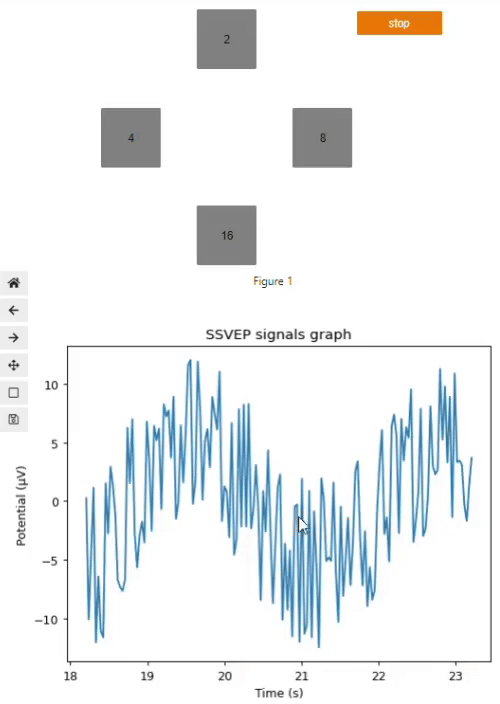
SSVEP
SSVEP simulator explanation:
The following is a simulation that shows how using ssvep-based brain computer interface (BCI) looks like.
The four buttons simulate the interface, with each button having different flashing frequency.
By clicking on a button you simulate the user concentrating on said button.
The graph, which simulates brain signal detection of the ssvep signal, will change its frequency according to the frequency observed by the user (or in our simulation case clicked by us).
The BCI system then understands which button the simulated user supposedly looked at by searching for the button with the correlating flashing frequency.
Two options to run the code for this simulation (read the instructions inside the file):
1. Copy this following link to Google Colab notebook (low refresh rate):
https://colab.research.google.com/drive/1xBp9y8zhg65Ipqp3PjumPbKtMNlTf6B-?usp=drive_link
2.Better option with great refresh rate (here I worked on the code). Note that you may need to sign up to anaconda in order to use the notebook.
https://anaconda.cloud/share/notebooks/9df9c40e-42d2-4e95-a1bf-54c0a1440b61/overview


Overview of SSVEP in BCIs
Steady-State Visually Evoked Potentials (SSVEP) are oscillatory brain responses triggered by visual stimuli that flicker at specific frequencies.
These potentials are generated primarily in the visual cortex and are most prominent when the stimuli flicker at frequencies between 5 Hz and 20 Hz.
SSVEPs are highly reliable and can be detected with minimal user training, making them particularly suitable for various BCI applications.
SSVEP and Related Paradigms

In a standard SSVEP-based BCI, multiple visual stimuli are presented simultaneously, each flickering at a different frequency. The user focuses on one of these stimuli, causing the brain to generate an SSVEP at the corresponding frequency. The BCI system detects this frequency and interprets it as the user's intended command. Variations of SSVEP paradigms include the use of non-rhythmic stimuli, although these are not strictly considered SSVEP paradigms but are often grouped with them for convenience.

Signal Detection and Processing
The detection of SSVEP signals involves analyzing the EEG for frequency components that match the flicker frequency of the stimuli.
The power spectrum of the EEG is typically analyzed, with peaks corresponding to the frequency of the attended stimulus and its harmonics.
This allows the BCI system to determine which stimulus the user is focusing on. Advanced methods such as Canonical Correlation Analysis (CCA) and Fast Fourier Transform (FFT) are used to enhance the detection accuracy.
Early SSVEP-Like BCIs

The "Brain Computer Interfaces: Principles and Practice" mentions early studies where visual evoked potentials (VEPs) were used as inputs for BCIs.
For example, Sutter (1992) developed a BCI using an m-sequence (c-VEP) stimulation paradigm, where the user could control a cursor or select letters by focusing on different visual stimuli.
These early systems laid the groundwork for the development of modern SSVEP-based BCIs.

Recent SSVEP-Based BCI Designs
Recent developments in SSVEP-based BCIs have explored a wide range of applications, including word processing, navigation tasks, and gaming. Innovations include the use of harmonic peaks to improve signal detection and the integration of SSVEP BCIs with other control modalities to enhance functionality.
Challenges in SSVEP-Based BCIs

Gaze dependence is a significant issue in SSVEP-based BCIs, as the system typically requires the user to focus directly on the flickering stimulus. This can be challenging for users with impaired gaze control or for those who experience visual discomfort from prolonged exposure to flickering stimuli. Researchers are exploring methods to reduce gaze dependence and improve user comfort.

Future Directions for SSVEP-Based BCIs
The future of SSVEP-based BCIs lies in refining signal processing techniques, exploring alternative stimuli to reduce visual discomfort, and integrating SSVEP with other control modalities. Gaze-independent SSVEP BCIs, which do not require the user to fixate on the stimulus, are an exciting area of research that could expand the applicability of these systems.
Quick quiz to check your understanding
1.What does SSVEP stand for?
A) Steady-State Visually Evoked Potentials
B) Steady-State Voltage Emission Potentials
C) Slow-State Visual Evoked Potentials
D) Steady-State Verbal Emission Patterns
2.Which method is often used in SSVEP-based BCIs to increase the accuracy of signal detection?
A) Use of longer inter-stimulus intervals
B) Random presentation of stimuli
C) Enhanced signal processing techniques such as Canonical Correlation Analysis (CCA)
D) Use of auditory cues alongside visual stimuli
3.What is a common range of frequencies for stimuli that generate strong SSVEP responses?
A) 1-4 Hz
B) 5-20 Hz
C) 21-40 Hz
D) 41-60 Hz
4.What is a significant challenge in SSVEP-based BCIs?
A) The need for extensive user training
B) Invasive nature of the technology
C) Gaze dependence and visual discomfort from flickering stimuli
D) Low information transfer rate
5.What method is commonly used to detect SSVEP signals in EEG data?
A) Fourier Transform
B) Averaging of multiple trials
C) Magnetoencephalography (MEG)
D) Skin conductance measurements
1.What does SSVEP stand for?
A) Steady-State Visually Evoked Potentials
2.Which method is often used in SSVEP-based BCIs to increase the accuracy of signal detection?
C) Enhanced signal processing techniques such as Canonical Correlation Analysis (CCA)
3.What is a common range of frequencies for stimuli that generate strong SSVEP responses?
B) 5-20 Hz
4.What is a significant challenge in SSVEP-based BCIs?
C) Gaze dependence and visual discomfort from flickering stimuli
5.What method is commonly used to detect SSVEP signals in EEG data?
A) Fourier Transform
References and Sources to read & learn more on SSVEP:
1. Wolpaw, Jonathan, and Elizabeth Winter Wolpaw (eds), Brain–Computer Interfaces: Principles and Practice (2012; online edn, Oxford Academic, 24 May 2012), https://doi.org/10.1093/acprof:oso/9780195388855.001.0001, accessed 27 August. 2024.
2. S. Amiri, A. Rabbi, L. Azinfar, and R. Fazel-Rezai, ‘A Review of P300, SSVEP, and Hybrid P300/SSVEP Brain- Computer Interface Systems’, Brain-Computer Interface Systems - Recent Progress and Future Prospects. InTech, Jun. 05, 2013. doi: 10.5772/56135.
A Review of P300, SSVEP, and Hybrid P300/SSVEP Brain- Computer Interface Systems | IntechOpen